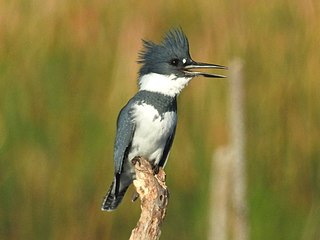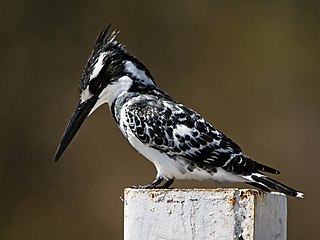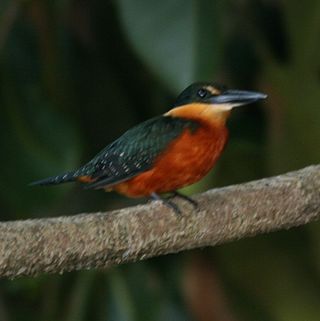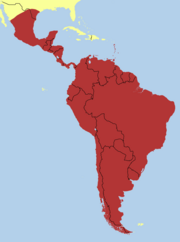
Kingfishers are a family, the Alcedinidae, of small to medium-sized, brightly coloured birds in the order Coraciiformes. They have a cosmopolitan distribution, with most species living in the tropical regions of Africa, Asia, and Oceania, but also can be found in Europe and the Americas. They can be found in deep forests near calm ponds and small rivers. The family contains 118 species and is divided into three subfamilies and 19 genera. All kingfishers have large heads, long, sharp, pointed bills, short legs, and stubby tails. Most species have bright plumage with only small differences between the sexes. Most species are tropical in distribution, and a slight majority are found only in forests.

The belted kingfisher is a large, conspicuous water kingfisher, native to North America. All kingfishers are placed in one family, Alcedinidae, and recent research suggests that this should be divided into three subfamilies.

The river kingfishers or pygmy kingfishers, subfamily Alcedininae, are one of the three subfamilies of kingfishers. The river kingfishers are widespread through Africa and east and south Asia as far as Australia, with one species, the common kingfisher also appearing in Europe and northern Asia. This group includes many kingfishers that actually dive for fish. The origin of the subfamily is thought to have been in Asia.

The water kingfishers or Cerylinae are one of the three subfamilies of kingfishers, and are also known as the cerylid kingfishers. All six American species are in this subfamily.

The pied kingfisher is a species of water kingfisher widely distributed across Africa and Asia. Originally described by Carl Linnaeus in 1758, it has five recognised subspecies. Its black and white plumage and crest, as well as its habit of hovering over clear lakes and rivers before diving for fish, make it distinctive. Males have a double band across the breast, while females have a single broken breast band. They are usually found in pairs or small family groups. When perched, they often bob their head and flick up their tail.

The malachite kingfisher is a river kingfisher which is widely distributed in Africa south of the Sahara. It is largely resident except for seasonal climate-related movements.

The half-collared kingfisher is a kingfisher in the subfamily Alcedininae that is found in southern and eastern Africa. It feeds almost exclusively on fish and frequents streams, rivers and larger bodies of water with dense shoreline vegetation.

The American green kingfishers are the kingfisher genus Chloroceryle, which are native to tropical Central and South America, with one species extending north to south Texas.

The giant kingfisher is the largest kingfisher in Africa, where it is a resident breeding bird over most of the continent south of the Sahara Desert, other than the arid southwest.

The American pygmy kingfisher is a species of "water kingfisher" in subfamily Cerylinae of family Alcedinidae. It is found in the American tropics from southern Mexico south through Central America into every mainland South American country except Chile and Uruguay. It also occurs on Trinidad.

The African pygmy kingfisher is a small insectivorous kingfisher found in the Afrotropics, mostly in woodland habitats.

The crested kingfisher is a very large kingfisher that is native to parts of southern Asia. It is part of the kingfisher genus (Megaceryle) with three other species: the giant kingfisher, the ringed kingfisher, and the belted kingfisher with which it forms a species complex.

Pelargopsis is a genus of tree kingfishers that are resident in tropical south Asia from India and Sri Lanka to Indonesia.

Todiramphus is a genus of kingfishers in the subfamily Halcyoninae that are endemic to the Philippines, New Guinea, Australia, New Zealand and many islands in the South Pacific.

The ringed kingfisher is a large, conspicuous, and noisy kingfisher bird commonly found along the lower Rio Grande Valley in southeasternmost Texas in the United States through Central America to Tierra del Fuego in South America.

The green-and-rufous kingfisher is a species of "water kingfisher" in subfamily Cerylinae of family Alcedinidae. It is found in the American tropics from Nicaragua to Panama and in every mainland South American country except Argentina, Chile, and Uruguay.

Alcedo is a genus of birds in the kingfisher subfamily Alcedininae. The genus was introduced by Carl Linnaeus in 1758 in the 10th edition of his Systema Naturae. The type species is the common kingfisher. Alcedo is the Latin for "kingfisher".

The black-backed dwarf kingfisher, also known as the three-toed kingfisher, is a pocket-sized bird in the family Alcedinidae. It was formerly considered as conspecific with the rufous-backed dwarf kingfisher and together the species complex was known by the English name "oriental dwarf kingfisher".

Ispidina is a genus of small insectivorous African river kingfishers.

Corythornis is a genus of small African river kingfishers.








































